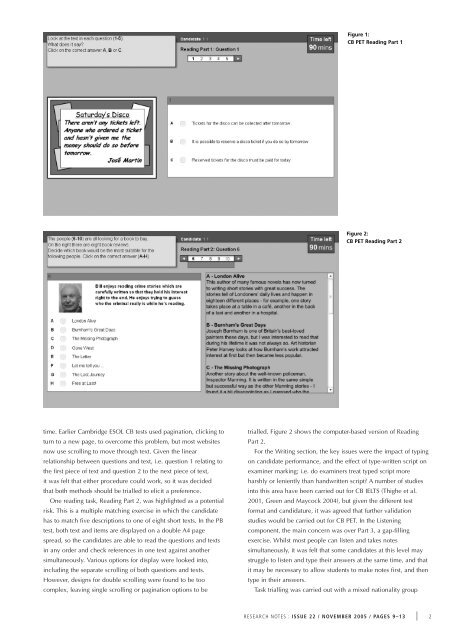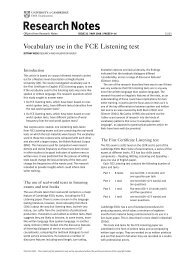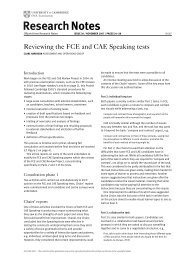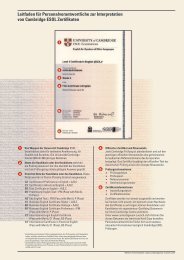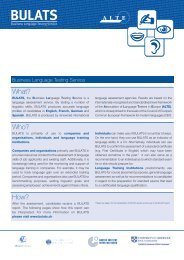Figure 1:CB PET Reading Part 1Figure 2:CB PET Reading Part 2time. Earlier <strong>Cambridge</strong> ESOL CB tests used pagination, clicking toturn to a new page, to overcome this problem, but most websitesnow use scrolling to move through text. Given the linearrelationship between questions and text, i.e. question 1 relating tothe first piece of text and question 2 to the next piece of text,it was felt that either procedure could work, so it was decidedthat both methods should be trialled to elicit a preference.One reading task, Reading Part 2, was highlighted as a potentialrisk. This is a multiple matching exercise in which the candidatehas to match five descriptions to one of eight short texts. In the PBtest, both text and items are displayed on a double A4 pagespread, so the candidates are able to read the questions and textsin any order and check references in one text against anothersimultaneously. Various options for display were looked into,including the separate scrolling of both questions and texts.However, designs for double scrolling were found to be toocomplex, leaving single scrolling or pagination options to betrialled. Figure 2 shows the computer-based version of ReadingPart 2.For the Writing section, the key issues were the impact of typingon candidate performance, and the effect of type-written script onexaminer marking; i.e. do examiners treat typed script moreharshly or leniently than handwritten script? A number of studiesinto this area have been carried out for CB IELTS (Thighe et al.2001, Green and Maycock 2004), but given the different testformat and candidature, it was agreed that further validationstudies would be carried out for CB PET. In the Listeningcomponent, the main concern was over Part 3, a gap-fillingexercise. Whilst most people can listen and takes notessimultaneously, it was felt that some candidates at this level maystruggle to listen and type their answers at the same time, and thatit may be necessary to allow students to make notes first, and thentype in their answers.Task trialling was carried out with a mixed nationality groupRESEARCH NOTES : ISSUE 22 / NOVEMBER 2005 / PAGES 9–13 | 2
of students preparing for PB PET in March 2004. Feedback fromtrialling was positive, with few problems being encountered by thestudents. Scrolling was found to be more popular than paginationas a method of moving through text, and black font on a bluebackground the favoured colour option for text and questions;as opposed to black on white, or white on blue. Reading Part 2appeared to present few problems in scrolling format with onequestion on-screen at a time. It may be that restricting the numberof questions a candidate can read at one time actually engenders amore efficient reading process and it is hoped that further researchinto the mechanics of reading on-screen versus on paper can becarried out in future. In writing, a preference for seeing questionsone at a time was expressed for Part 1, and most candidates foundtyping as easy or easier than having to write by hand in Parts 2and 3. In the listening section, candidates preferred the option ofseeing all the questions at one time and a number of candidatesexpressed a desire to make notes first then type in Part 3.Navigation design and triallingOnce task templates had been trialled and designs modified, thenavigation system was developed more fully. The main aim in thedevelopment of the on-screen navigation toolbars was to allowcandidates to progress through the test as they would in the PBformat, choosing which questions to answer first and being able toreturn to questions at any time during the test. The design teamdrew heavily on standard navigation toolbars and practices usedon websites. The main navigation was positioned at the bottom ofthe page, listing all parts of the test and this also indicated whichquestions had been answered. In addition to this, a part or subnavigationwas positioned above each task being attempted. Thisallowed easy navigation between the questions in a particular partof the test. Finally, a ‘next’ button appeared each time a questionwas answered, allowing candidates who wished to progressthrough the test in question order to do so. Figure 3 shows anextract from the CB Listening paper.Navigation trialling was tested on a mixed-nationality group ofCommon European Framework A2/B1 level students from a UKlanguage school in April 2004. These students were not on a PETpreparation course, as it was felt that if non-PET candidates withlittle or no knowledge of the test format were able to successfullynavigate through the test, this should not present a problem for realPET candidates. Results of navigation trialling were veryencouraging, with all candidates being able to work their waythrough the test without instruction. A few candidates hadproblems with Reading Part 2, but in the focus group it emergedthat they were unfamiliar with this task type. It also emerged thatthe rubric was not always being read, possibly due to the fact thatit was of less prominence than on the PB test. The rubric box wasredesigned with a clearer border and a shaded background tomake it stand out more.Despite the relative ease with which candidates navigatedthrough the test, it was agreed that both components: Reading andWriting, and Listening, would contain a brief tutorial, available tocandidates prior to starting the main test screen. One further aspectto arise out of navigation trialling was that some candidatesexpressed a wish to erase earlier answers, a function which theresponse buttons did not allow, as once selected they could beswitched to another answer, but not cleared. This functionality wasadded to the system ahead of equivalence trialling.Equivalence triallingEquivalence trialling took place in February 2005 with 190candidates at selected centres in Ireland (with Spanish speakingFigure 3:CB PET Navigation LayoutRESEARCH NOTES : ISSUE 22 / NOVEMBER 2005 / PAGES 9–13 | 3


